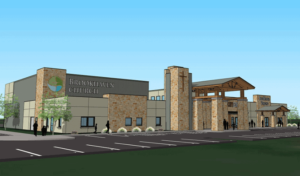Abandoned church buildings of all shapes and sizes dot the American landscape—from the Northeast to the Southwest. A massive steepled brick church on Main Street in my city was torn down a few years ago. The congregation could no longer afford to keep it open, and the city block was coveted. The newspaper reported outrage, but it didn’t matter. The church couldn’t sustain its piece of history with a declining member base, a fuzzy vision, and outdated strategies.
Here at The Unstuck Group, we help churches deal with the fuzzy vision and strategy part, and for certain, churches decline first and foremost because they stop connecting with people. However, we have some friends at Building God’s Way who can point to another reason why churches end up sitting empty: a failure to see how their facilities can be leveraged to actually sustain ministry.
Eric Bahme, CEO of BGW Sustainable Solutions, sees churches building sustainable forms of ministry that help them invest more of their resources into the actual mission. He shared some thoughts with me on a call last week.
1. How do you define sustainability as it relates to church and ministry facilities?
It’s more than just the building and how it was built. We define sustainability as a focus on longevity. You want to build your ministry to last. Every ministry has to have “people flow” and “money flow;” without both, you won’t be sustainable.
There are all kinds of reasons why churches need to feel the urgency of thinking more sustainably. Millennials aren’t giving to the local church; they have different priorities. Boomers are starting to pass away. Churches will likely have to start paying property taxes in the not-too-distant future. We need to start thinking differently.
2. How can churches take a more sustainable approach?
I was a senior pastor for 14 years. I started a church in Portland, OR where we saw nontraditional thinking about church facilities do amazing things. Our church opened one hotel and operated another. We had six weekend services, multiple church plants, job training programs and a drug rehab program. We thought of ourselves as mission-based entrepreneurs, and it was the best form of evangelism I’ve ever stumbled across—we saw 3,000+ people meet Christ through the hotel alone!
Today, only 0.3% of a church’s money goes into what they say they are about. The vast majority of it goes to buildings and salaries. You can let the building pay for itself! You’ll actually attract more Millennials—and they’ll be more likely to give—if you’re putting your money towards your cause, rather than your buildings.
This kind of thinking means you don’t put money ahead of your mission. The businesses promote the people-flow, while also solving the economics.
3. What are some of the most innovative things you’re seeing?
We’re seeing churches get out from behind the stained glass windows and into the marketplace. They own hotels, child care centers, senior housing, mixed-use retail space, and athletic centers, for example. Two churches we know—Hub801 (Genesis Ogden, UT) and Believers Church (Chesapeake VA)—operate successful event spaces.
The businesses are funding ministry. They don’t replace the need to build a culture of generosity within the congregation, but they exponentially increase the ministry’s capacity to reach out.
4. What are some of the first questions a church needs to consider when it’s exploring this path?
These are what immediately come to mind:
- Are you willing to change?
- What resources do you already have? Property? Entrepreneurs? Land?
- What are the needs of your community from an economic standpoint? Don’t build a hotel or child care center if there’s no need.
- Do you have enough space to combine a business and a church’s needs?
5. Can a church with an existing building, or a traditional building, do this?
Some of the old buildings can be converted into nice event centers. Other times, the property is worth more than the building. You can sometimes tear down the existing building, and with the equity, put up a multi-use property. Banks will lend based off the business potential rather than the giving records of the church. So, yes, an existing building doesn’t have to be a limitation.
6. What else do church leaders need to know as they consider how to become more sustainable as a ministry?
We recommend churches do not operate the businesses. We suggest they hire an outside management company (we have a number we recommend) to run the businesses. Churches get the benefit of ministering to the people, and the revenue, but they don’t run the business. If there’s an issue, the church can always fire the management company.







